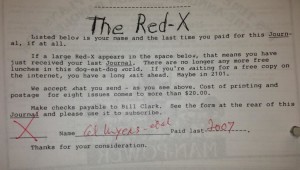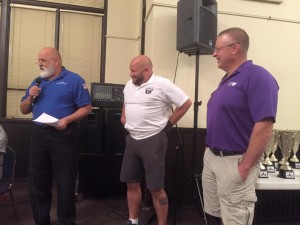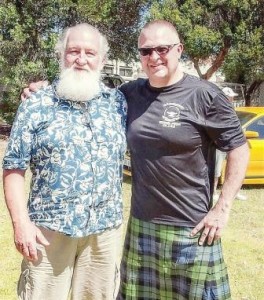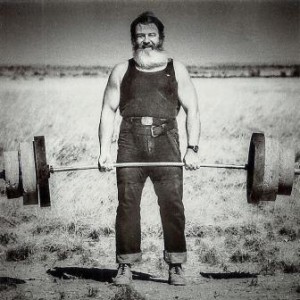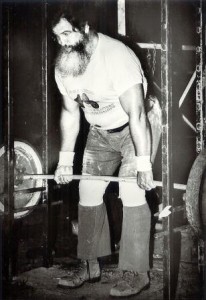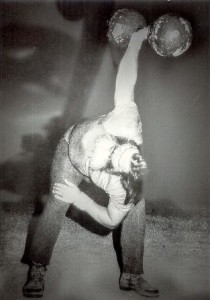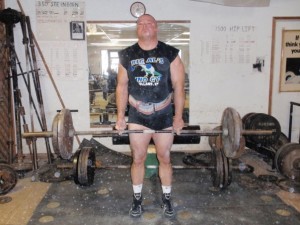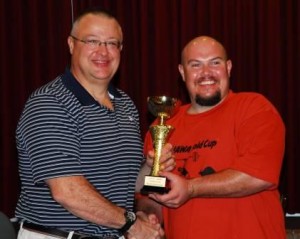The “Dreaded Red X”
by Thom Van Vleck
My roots in the USAWA go way back. My first meet was a 1979 “Odd Lift” meet put on by the founder of the USAWA, Bill Clark. But before that my Uncles and their friends often lifted in Clark’s meets going back to the fifties. Clark founded the USAWA but he actually didn’t start the “Odd Lifts”. That goes back to Ed Zercher, Sr who was a great lifter in the 30’s and after. But even before Ed was in his first contest he had a buddy in his old neighborhood in St. Louis named John Wille. In the 1920’s they hung out in the same neighborhood and they did acrobatics, lifting whatever was available, and made make shift weights out of scrap metal.
Today we look to the internet. The USAWA has a great website. Al Myers does a lot of work to keep this thing going and having regular updates. But for 50 years it was “Ol’ Clark”. Bill was old school in an old school way that made a lot of old school stuff seem new! He never touched a computer. For 50 years he put out old fashioned newsletters. For you young guys, that means he typed up the newsletter on a typewriter, then he copied the news letter (on a Mimeograph and later a copy machine), and he would put them in envelopes, actually lick the stamps (because they didn’t just stick on like they do now) and mail them to your actual mailbox (not the “mailbox” that your e-mail comes to).
I remember looking through all the old newsletters my Uncles had. Reading about the lifts, the lifters, the meets and random thoughts (and sometimes rants) that Clark would have about steroids, improper judging, or whatever he thought was undermining the integrity of the sport. If you sent him a letter, be careful, he’d put it in the newsletter!
He operated all this on a shoe string budget and his own sweat. He probably spent a lot of his own money. But he did ask donations. You could get the newsletter if you sent him even just a few bucks to pay for the stamps! He would also include in almost every newsletter a little rant about “bucking up” and make jokes about not being a deadbeat.
He would have a list of people that gave money. He would even put how much they gave. I think to give credit to those who gave more than their fair share because they loved the sport. Those that gave often really valued the information and back then there was no internet and finding out much of anything about weightlifting was about impossible). He also would “Red X” the guys who hadn’t “paid up” for some time. He would put what he called the “Dreaded Red X” on the front of your newsletter. It kind of reminded me how teachers would mark up your papers with red ink when you got something wrong. The funny part was he would often keep sending guys newsletters for a long time. Especially so if he knew someone was on hard times. Like my Uncle Wayne. Clark could be really nice that way.
In some ways I think Ol’ Clark got vilified a bit for his “Red X” and other things he did when he would call out guys for not following established rules. He sometimes had a way of making a remark about it the next time you would see him to let you know his displeasure….one might even call it a snide remark.
But you know what. Now that I’m older. Now that I’ve been in the position of running organizations that get by on shoe string budgets and I’ve put in long hours to run highland games, strongman contests, lifting meets as well as three different weightlifting clubs (Jackson Weightlifting Club, Truman State Irondogs, and the A.T. Still University Osteoblasters) as well as other Church and community organizations that ONLY happen because the people involved reach in their pockets and pull out some cash that includes more than a few drops of sweat…..I get it.
That bring me to present day. When Ol’ Clark ran that newsletter you saw the stamp. You knew it cost money. You knew the paper, the ink, the copies, and all that went into it cost money so I think it was easier to see how much all of it cost. Well, now Al Myers stepped in and took it over some 8 years ago. He created a website, then got a better one, and did a lot of work to keep it going and at what cost. I bet a lot more than the stamps Ol’ Clark used. At the least, I would say both men work (worked) equally hard.
So what can you do? Send him a few hundred bucks! Well, that would be nice but I think the best thing we could do as an organization is support the guys that make it happen. Not just Al, but our officers, judges, etc. We do this by following the rules, getting meet results to Al in a timely manner, make sure our meets are as legit as we can, write a good story for the meet results for the website, maybe send Al a good story or anecdote for the website (like how people would send Clark a letter) and he’d put in on the website. Buy Al a beer, slap him on the back….heck, I bet a thanks would go a long way.
Otherwise, people like Bill and Al get burned out. They love a sport and after awhile they feel unappreciated and frustrated and next thing you know…..well, let’s just try and do our part and keep the USAWA great. It’s only as great as the people who run it and the people who are a part of it AND appreciate it!
